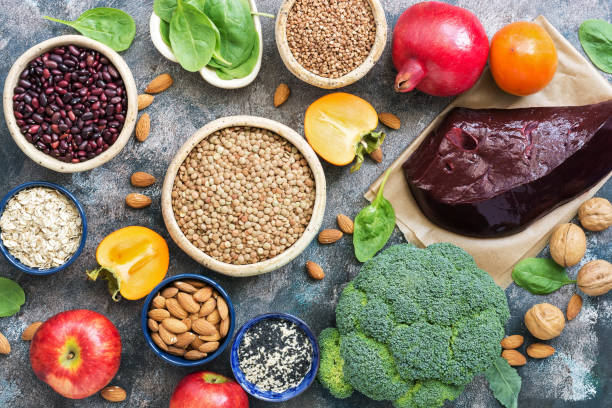What you need to know about anaemia
Some anaemias, such as iron deficiency anaemia or vitamin B-12 deficiency, are common and can be treated with dietary supplements.

Picture: iStock
Your body makes three types of blood cells which are white blood cells to fight infection, platelets to help your blood clot and red blood cells to carry oxygen throughout your body. Red blood cells contain haemoglobin, an iron-rich protein that gives blood its red colour.
Haemoglobin enables red blood cells to carry oxygen from your lungs to all parts of your body and to carry carbon dioxide from other parts of the body to your lungs so that it can be exhaled.
Most blood cells, including red blood cells, are produced regularly in your bone marrow – a spongy material found within the cavities of many of your large bones.
To produce haemoglobin and red blood cells, your body needs iron, vitamin B-12, folate and other nutrients from the foods you eat.
Anaemia is a condition in which a person does not have enough healthy red blood cells to carry oxygen to the body’s tissues which may make you feel tired and weak.
Anaemia can be temporary or long term, and it can range from mild to severe. Treatments for anaemia range from taking supplements to undergoing medical procedures. You may be able to prevent some types of anaemia by eating a healthy, varied diet.
Some anaemias, such as iron deficiency anaemia or vitamin B-12 deficiency, are common.
Fatigue has many causes besides anaemia, so don’t assume that if you’re tired you must be anaemic. Some people learn that their haemoglobin is low, which indicates anaemia, when they go to donate blood.
Symptoms may include:
- Fatigue
- Weakness
- Pale or yellowish skin
- Irregular heartbeats
- Shortness of breath
- Dizziness or lightheadedness
- Chest pain
- Cold hands and feet
- Headache

Headache. Picture: iStock
Causes
Anything that causes your body to not have enough red blood cells will cause anaemia. It can be because:
- Your body doesn’t make enough red blood cells;
- Bleeding causes you to lose red blood cells more quickly than they can be replaced;
- Your body destroys red blood cells.
Different types of anaemia and their causes include:
• Iron deficiency anaemia. This is the most common type of anaemia. It is caused by a shortage of iron in your body. Your bone marrow needs iron to make haemoglobin. Without adequate iron, your body can’t produce enough haemoglobin for red blood cells.
Without iron supplementation, this type of anaemia occurs in many pregnant women. It is also caused by blood loss, such as from heavy menstrual bleeding, an ulcer, cancer and regular use of some over-the-counter pain relievers, especially aspirin.
• Vitamin deficiency anaemia. In addition to iron, your body needs folate and vitamin B-12 to produce enough healthy red blood cells. A diet lacking in these and other key nutrients can cause decreased red blood cell production.
Additionally, some people may consume enough B-12, but their bodies aren’t able to process the vitamin. This can lead to vitamin deficiency anaemia, also known as pernicious anaemia.
• Anaemia of chronic disease. Certain diseases – such as cancer, tuberculosis, HIV/Aids, rheumatoid arthritis, kidney disease, Crohn’s disease and other chronic inflammatory diseases – can interfere with the production of red blood cells.
• Aplastic anaemia. This rare, life-threatening anaemia occurs when your body doesn’t produce enough red blood cells. Causes of aplastic anaemia include infections, certain medicines, autoimmune diseases and exposure to toxic chemicals.
• Anaemias associated with bone marrow disease. A variety of diseases, such as leukaemia and myelofibrosis, can cause anaemia by affecting blood production in your bone marrow.
• Haemolytic anaemias. This group of anaemias develops when red blood cells are destroyed faster than bone marrow can replace them. Certain blood diseases increase red blood cell destruction. You can inherit a haemolytic anaemia, or you can develop it later in life.
• Sickle cell anaemia. This sometimes serious condition is an inherited haemolytic anaemia. It’s caused by a defective form of haemoglobin that forces red blood cells to assume an abnormal crescent (sickle) shape. These irregular blood cells die prematurely, resulting in a chronic shortage of red blood cells.

Foods high in iron. Picture: iStock
Treatment
Anaemia treatment depends on the cause.
• Iron deficiency anaemia. Treatment for this form of anaemia usually involves taking iron supplements and making changes to your diet.
• Vitamin deficiency anaemias. Treatment for folic acid and B-12 deficiency involves dietary supplements. If your digestive system has trouble absorbing vitamin B-12 from the food you eat, you may need vitamin B-12 shots.
• Anaemia of chronic disease. If symptoms become severe, a blood transfusion or injections of synthetic erythropoietin, a hormone produced by your kidneys, may help stimulate red blood cell production and ease fatigue.
• Aplastic anaemia. Treatment for this anaemia may include blood transfusions to boost levels of red blood cells.
• Anaemias associated with bone marrow disease. Treatment of these various diseases can include medication, chemotherapy or bone marrow transplantation.
• Haemolytic anaemias. A blood transfusion or plasmapheresis may be necessary. Plasmapheresis is a type of blood-filtering procedure.
• Sickle cell anaemia. Treatment for this anaemia may include the administration of oxygen, pain-relieving drugs, and oral and intravenous fluids to reduce pain and prevent complications.
For more news your way, download The Citizen’s app for iOS and Android.
For more news your way
Download our app and read this and other great stories on the move. Available for Android and iOS.





